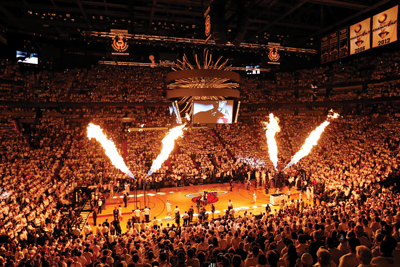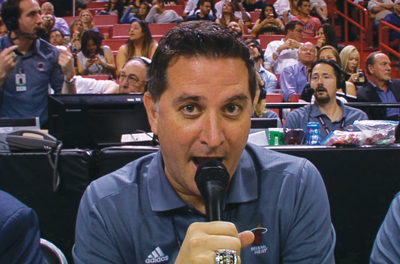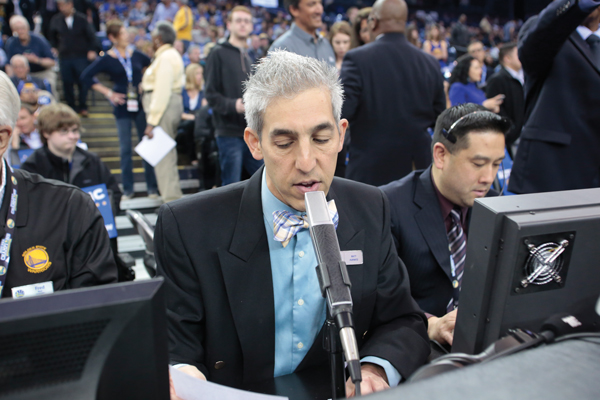 |
The Golden State Warriors’ Matt Hurwitz talks a good game.
Photo by: GOLDEN STATE WARRIORS
|
Maybe it’s “Stand Up And Make Some Noise!”
Perhaps it’s “DEE-TROIT BASKET-BALL!”
Or, how about the more low-key delivery that’s heard out West, at Oracle Arena (relatively speaking, at least).
It’s the signature style of your NBA team’s public address announcer. And whether you find the calls obnoxious or entertaining, or both, they’ll likely be ringing in your head long after you leave the arena — even if the people behind the calls say they aren’t trying to make that happen.
Those individuals: They’re the ringleaders in many respects for the NBA’s in-game carnival. As the playoffs approach, and postseason series start to play out, you’ll probably start to notice them more and more, even if you’re watching in your living room thousands of miles away.
Take a listen
Hear for yourself how some of the NBA’s team PA announcers make their calls.
Theirs are also among the toughest jobs to get in sports, with openings coming rarely, to say the least. Consider that since 2010, only four of the league’s 30 teams (Brooklyn, Indiana, Oklahoma City and San Antonio) have had their PA announcer jobs turn over.
The longest-tenured announcer in the league is Dan Roberts, who has been with the Utah Jazz since the Jimmy Carter administration — when the team moved to Salt Lake City from New Orleans in 1979. The most recent announcer opening was filled by Jonathan Sanford, who took over the mike in San Antonio for the Spurs a mere three years ago, in 2013.
The league keeps its eyes (and ears) open with regard to what’s happening in these positions, but filling these slots: That’s the team’s domain. Teams know their local markets best, and once a hire is made, that person settles in — and brings the crowd along for the ride.
“It’s the nature of the beast,” said Danny Meiseles, president and executive producer of content for the NBA. “Fans get comfortable, they like repetition and they like the entertainment, and teams do as well.”
■ ■ ■
So how do the people who have these jobs get them? Big pipes and a strong delivery are obviously key, but like almost every other job in sports, so too is timing.
Michael Baiamonte has been with the Miami Heat since 1991. When the Heat came to South Florida in 1988, he was working in the insurance industry by day and announcing basketball games at Florida International University by night. Calling FIU games gave him some relevance, and he routinely sent letters to the Heat expressing his interest in becoming the team’s PA
announcer. But he routinely was told in response: “Don’t call us; we’ll call you.”
During the Heat’s second season, the team did call — with a desperate proposition. Could Baiamonte fill in for the regular Heat PA announcer, Dave Axelson, who’d taken ill for a game that very night.
“I immediately thought, ‘Which one of my friends is pulling my
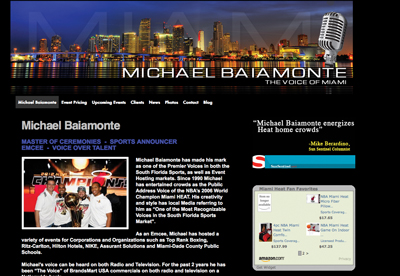 |
Michael Baiamonte, well-known around the NBA for helping fire up the Heat crowd, books outside work through his own website.
Photo by: MIAM HEAT (2)
|
leg,’” Baiamonte said. “Once I realized it was legit, I went and did my thing.”
After his one-game fill-in performance, the Heat stayed in touch, and Baiamonte did preseason PA work for the team the following year. When Axelson left the job before the start of the 1991-92 season, Baiamonte figured he had the golden ticket.
“I picked up the phone and said ‘I’m ready,’” he said. “But I was told, ‘Not so fast.’”
Instead, Baiamonte, 52, had to send in a cassette tape as a means of an audition and spend an anxious few weeks wondering if he made the cut before he was hired as the full-time announcer.
Such was the beginning of one of the more bombastic PA announcers in the NBA.
“Some say it is over the top, but our fans are there to enjoy the players,” Baiamonte said. “They are the stars. What works in one city may not work in another.”
Baiamonte gets a script in advance of the game on game nights, and he always looks over the visiting team rosters for any difficult-to-announce player names. (Can you say “Giannis Antetokounmpo” of the Milwaukee Bucks?) He arrives at the arena two hours before the game, has dinner, and inputs both team rosters into his tablet, which holds the game script. He then takes his seat at the scorer’s table one hour before tipoff and begins any pregame announcements 30 minutes before game time.
Baiamonte wouldn’t say how much he’s paid per game; he’s a contract worker for the Heat. That compares to others who are paid on a per-game basis, and still others who work as full-time employees of their teams. Compensation for the jobs follows from that range of employment terms. For many, it’s around $300 a night. Those who are on staff full-time earn more, getting paid in line with what other full-time employees working event and entertainment operations make.
In Baiamonte’s case, as one of the more well-known PA announcers in the NBA, he also does a lot of outside work, some of which is booked through his website, voiceofmiami.com.
Some of his most popular non-NBA gigs? Weddings and bar mitzvahs.
“A big part of my business is live events,” he said. “I introduce bridal parties like I introduce starting lineups.”
■ ■ ■
As public address announcer for the Cleveland Cavaliers since 2006, Olivier Sedra has had a front-row seat to watch LeBron James work at Quicken Loans Arena. But getting the job required a tryout that called for Sedra to announce a game not with NBA all-stars, but rather with Cavs front-office staffers. A pick-up game. One squad wore red jerseys, the other wore blue. It was a five-minute game that included a timeout and a halftime as if it were a real game.
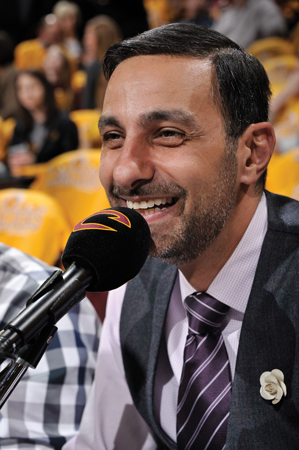 |
The Cavaliers’ Olivier Sedra: “We have a lot of bells and whistles, but I am not the show.”
Photo by: DAVID LIAM KYLE / GETTY IMAGES
|
It was up to Sedra to prove his PA chops in front of Cavs executives as he read prompts and called the action.
Sedra got a call back a few days later to call another mock game, again with front-office staffers serving as the players. This time, Sedra was videotaped and recorded as he was put through the paces with six other finalists in front of top team brass.
Sedra knew he got the job when he was sent over to meet Cavs owner Dan Gilbert, who gave his approval.
“He made me feel comfortable instantly,” Sedra said.
Sedra, 40, also works the Gilbert-owned AHL Lake Erie Monsters games and does team events as part of his job with the Cavs. Sedra too, like Baiamonte, is handed a script before each home game that includes all of the sponsor reads during various parts of the game. But he’s free to create his own style within the script framework.
“We have a lot of bells and whistles, but I am not the show,” Sedra said. “I come in, assimilate to the crowd, and when the game is over, you don’t want the crowd to remember you; you want them to remember the game.”
But unlike Baiamonte, a contract worker, Sedra is a full-time Cavs staffer.
“We wanted more of a commitment,” said Tracy Marek, the Cavs’ chief marketing officer, who oversees the in-game operations for the Cavs. “We expect him to have a voice in everything we do. It’s not just that you are the PA announcer but that you are a piece of the puzzle, and we encourage ideas that help build on what we are doing.”
Perhaps underscoring the faith the Cavs have in Sedra — and the importance they place on his work — Sedra has no backup. Should a night come when he needs to miss a game, the team most likely would make a call to its nearby D-League team, the Canton Charge, Marek said. After all, the D-League is as much a place for front-office, off-court development as it is for players’ on-court development.
Ultimately, for the Cavs, the PA announcer’s role is to guide fans through the game.
“You have got to build rapport where it’s authentic and not forced,” Marek said. “You can’t coach that.”
■ ■ ■
A PA announcer’s style is often a reflection of his team’s culture. (And yes: All 30 of the NBA’s current PA announcers are men.) No way Baiamonte’s style would work in San Antonio with the more buttoned-down Spurs organization, a place where everyone works to win but seemingly tries to do so without being noticed.
Sanford, the Spurs’ PA announcer, knows that trait well.
“It is about the team and projecting the ‘Spurs way,’” Sanford said. “I have a little bit of a growl sound, but this organization is not about flash.”
 |
The Spurs’ Jonathan Sanford: “It is about the team and projecting the ‘Spurs way.’”
Photo by: TONY MORANO
|
A church youth minister by day, Sanford had to be pushed into applying for an announcing job by his wife. In 2012, he was hired to announce the Spurs-owned WNBA Stars along with the Spurs’ D-League team. Before that, he’d been doing PA work at girls softball games at the high school and college levels with his dad as the spotter.
“It was the last day of the deadline to submit a demo,” Sanford said of applying for that WNBA/D-League job in 2012. “I watched a video of a Spurs playoff game and recorded myself doing lineups and game calls. When I submitted it, I wiped it from my mind.”
After a year doing the WNBA and D-League games, the Spurs hired him to do their NBA games.
“I was playing with house money,” Sanford said.
Now, Sanford, 38, is known across San Antonio for his “Spurs ball!” possession call that regularly jolts fans to life. It’s a sharp contrast to what generally is a matter-of-fact PA style used throughout the game.
■ ■ ■
Matt Hurwitz has been the PA announcer for the Golden States Warriors since 2000. He’s seen the franchise evolve from one of the worst teams in the NBA to the current defending league champions and one of the hottest teams in sports.
But Hurwitz, 45, tries to be consistent in his calls no matter how spectacular Stephen Curry might be on a given night at Oracle Arena.
“My calls are situational-based,” Hurwitz said. “If Curry hits one or two 3-point plays, my call is different than if he hits four or five. The trouble is that he is hitting eight, nine and 10 threes, and I have to pace myself.”
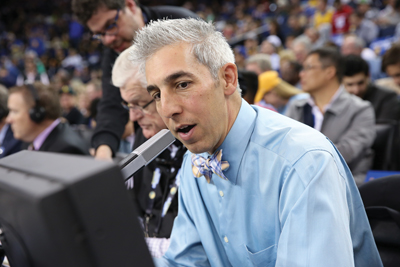 |
The Warriors’ Matt Hurwitz: “I don’t do nicknames or catchphrases.”
Photo by: GOLDEN STATE WARRIORS
|
A Bay Area native, Hurwitz has worked a variety of local PA jobs. He does PA work for the NAIA Menlo College football games, and his past jobs have been with the IHL San Francisco Spiders and the AFL San Jose SaberCats. He abides by a few steadfast self-imposed rules.
“First, respect the play on the court,” he said. “I don’t talk when there is any action.”
Rule No. 2: Don’t get cute.
“I don’t do nicknames or catchphrases,” he said. “That takes away from the game. It is a reflection of how our fans want to be treated. They are smart and loyal.”
For its part, the NBA keeps tabs on teams’ PA announcers and takes a best-practices approach in sharing what works and what doesn’t. It is a similar approach used by the league’s team marketing and business operations department, which helps teams share best practices in selling tickets and sponsorships.
“We do have rules in place to ensure they are not getting in the way of competitive balance,” Meiseles said. “There is no live announcing when the team has the ball, but we believe our teams know their markets best and the type of PA announcers they want to have.”
Baiamonte has a list of his own requirements, as well: announce who scored, who committed the foul, who is at the foul line, and that there are two minutes remaining in the quarter.
So as you hear their voices on the playoff nights ahead, whether you want to cheer with the crowd or choke on your hot dog as the announcers come to life, one thing is clear: The best PA announcer styles come naturally.
“It is up to me,” Hurwitz said, “and I’ve never been told to change in any capacity.”
In Their Own Words
Hear for yourselves how some of the NBA’s team PA announcers make their calls.



